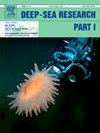热带西太平洋浮游有孔虫稳定氧同位素比值的垂直和季节变化及栖息地深度估算
IF 2.1
3区 地球科学
Q2 OCEANOGRAPHY
Deep-Sea Research Part I-Oceanographic Research Papers
Pub Date : 2025-02-01
DOI:10.1016/j.dsr.2024.104440
引用次数: 0
摘要
为了验证浮游有孔虫的生境深度,研究了热带西太平洋0 ~ 600 m水域有孔虫δ18O (δ18Opforam)随深度、季节、昼夜的变化规律。表面物种栖息在混合层包括4月Globigerinoides sacculifer, Globigerinoides红的白色,Globigerinoides conglobatus, Globigerinella siphonifera,和Orbulina universa(δ18 opforam−2.2‰~ -2.9‰)。Globorotalia hirsuta和Globorotaloides hexonus分别位于上温跃层(δ18Opforam,−0.3‰~ -1.2‰)和下温跃层(δ18Opforam, 1.2‰)。8月,白天有多种物种栖息在温跃层的最上层(sacullifer、G. ruber white、G. siphonifera、G. congloglobatus、O. universa、Globorotalia menardii、hatigerina pelagica、negloboquadrina dutertrei、Pulleniatina obliquiloculata和Globoquadrina glomata) (δ18Opforam,−2.2‰~ -3.2‰)。夜间,无囊棘球蛾和麻地棘球蛾主要栖息于地表混合层(δ18Opforam,−2.9‰~ -3.4‰)。8月,G. hexonus栖息于下温跃层(δ18Opforam, 1.3‰)。12月δ18Opforam垂直分布与4月δ18Opforam相似。由δ18Opforam推断的生境深度与物种丰度估算的结果基本一致。不匹配的种有Globorotalia truncatulinoides(4月)、Globigerinoides elongatus(12月)、G. hirsuta(8月)和G. hexagonus(12月)。δ18O分析结果表明,长尾螺生活在最上层温跃层,长尾螺生活在表层混合层。在G. hirsuta和G. hexagonus中,它们分别栖息在上温跃层和下温跃层。研究结果有助于利用海洋沉积物中浮游有孔虫的地球化学分析重建该地区过去的温跃层结构。本文章由计算机程序翻译,如有差异,请以英文原文为准。
Vertical and seasonal variations in stable oxygen isotope ratio of living planktonic foraminifera and estimation of habitat depth in the western tropical Pacific
To verify the habitat depth of planktonic foraminifera, the variability of foraminiferal δ18O (δ18Opforam) by depth, season, day and night was investigated over a water depth of 0–600 m in the western tropical Pacific region. Species that inhabit the surface mixed layer in April include Globigerinoides sacculifer, Globigerinoides ruber white, Globigerinoides conglobatus, Globigerinella siphonifera, and Orbulina universa (δ18Opforam, −2.2‰ to –2.9‰). Meanwhile, Globorotalia hirsuta and Globorotaloides hexagonus inhabit the upper thermocline (δ18Opforam, −0.3‰to –1.2‰) and lower thermocline (δ18Opforam, 1.2‰), respectively. In August, various species inhabit the uppermost thermocline during the day (G. sacculifer, G. ruber white, G. siphonifera, G. conglobatus, O. universa, Globorotalia menardii, Hastigerina pelagica, Neogloboquadrina dutertrei, Pulleniatina obliquiloculata, and Globoquadrina conglomerata) (δ18Opforam, −2.2‰ to –3.2‰). At night, G. sacculifer without sac and G. menardii appear to inhabit the surface mixed layer (δ18Opforam, −2.9‰ to –3.4‰). G. hexagonus inhabits the lower thermocline (δ18Opforam, 1.3‰) in August. The vertical distribution of δ18Opforam in December was similar to that of April δ18Opforam. The habitat depths inferred from δ18Opforam were mostly consistent with those estimated from species abundance. Species that did not match were Globorotalia truncatulinoides (in April), Globigerinoides elongatus (in December), G. hirsuta (in August), and G. hexagonus (in December). The results of δ18O analysis suggest that G. truncatulinoides lives in the uppermost thermocline, and G. elongatus in the surface mixed layer. In the case of G. hirsuta and G. hexagonus, they inhabit the upper thermocline and lower thermocline, respectively. Our results contribute to research on reconstructing past thermocline structure using geochemical analysis of planktonic foraminifera in marine sediments in this region.
求助全文
通过发布文献求助,成功后即可免费获取论文全文。
去求助
来源期刊
CiteScore
4.60
自引率
4.20%
发文量
144
审稿时长
18.3 weeks
期刊介绍:
Deep-Sea Research Part I: Oceanographic Research Papers is devoted to the publication of the results of original scientific research, including theoretical work of evident oceanographic applicability; and the solution of instrumental or methodological problems with evidence of successful use. The journal is distinguished by its interdisciplinary nature and its breadth, covering the geological, physical, chemical and biological aspects of the ocean and its boundaries with the sea floor and the atmosphere. In addition to regular "Research Papers" and "Instruments and Methods" papers, briefer communications may be published as "Notes". Supplemental matter, such as extensive data tables or graphs and multimedia content, may be published as electronic appendices.

 求助内容:
求助内容: 应助结果提醒方式:
应助结果提醒方式:


